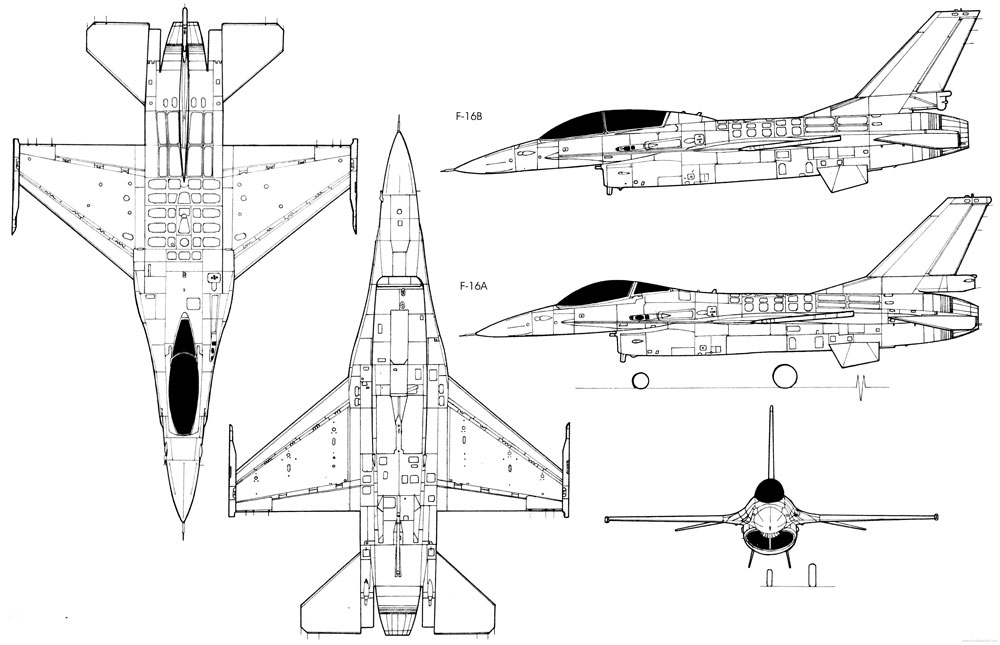The F-16 can fly at a top speed of Mach 2.05, or 1,318mph, by utilizing its afterburner.
Considered the backbone of the United States Air Force’s (USAF) fighter fleet for more than three decades, the F-16 Fighting Falcon has, and continues to play, an important role in air superiority. Evolving from a 1972 competition that called for a lightweight, highly maneuverable fighter jet, the F-16 won the contest and entered production in 1972. Part of its initial production included an agreement creating a consortium between the United States and four NATO countries: Belgium, Denmark, Netherlands and Norway. From then on, the F-16 evolved from an air superiority day fighter to an all-weather, multirole aircraft—still in use today around the globe.

Serial Number: 79-0388
Manufacturer: General Dynamics
Crew: One
Engines: One Pratt & Whitney F-100-PW-200 turbofan; 23,830 pounds thrust in afterburner
Wingspan: 32 feet 9 1/2 inches
Length: 49 feet 3 1/2 inches
Height: 16 feet 8 1/2 inches
Weight: 16,285 pounds (empty); 25,281 pounds (combat); 37,500 pounds (maximum)
Speed: 577 mph (cruising); 1,345 mph, Mach 2.05 (maximum)
Range: 340 miles (combat); 2,415 miles (transit)
Service Ceiling: 55,000 feet
Armament: One 20mm M61A1 rotary cannon; AIM-9 air-to-air missiles on wingtips; various ordnance
Cost: $8,200,000 (approximate)
In 1977, the USAF officially announced the 388th Tactical Fighter Wing (stationed at Hill Air Force Base) would be the first F-16-equipped, tactical fighter wing and later became the first Active Duty unit to receive the new F-16 for combat operational use. Later, the 419th Tactical Fighter Wing, also assigned to Hill Air Force Base, became the first Reserve unit to receive the new F-16.
Throughout the years, in addition to the operations mission, Hill Air Force Base has supported a robust F-16 maintenance mission—to include structural, electrical, commodities and software. Furthermore, Hill Air Force Base has been the home to the F-16 System Program Office for years, overseeing the development, acquisition, modernization, and sustainment of this multirole, combat aircraft.
The F-16A, proudly displayed in Hill Aerospace Museum, was manufactured by the Fort Worth Division of General Dynamics in Fort Worth, Texas. It was delivered to the USAF in November 1980. After delivery, it was assigned to the 57th Fighter Weapons Wing of the Tactical Air
The F-16 can fly at a top speed of Mach 2.05, or 1,318mph, by utilizing its afterburner.
The maximum range of the Falcon, without refueling, is dependent on several factors. Aircraft weight, use of external fuel tanks, and cruising speed versus full afterburn. It’s combat range is approx. 339mi while carrying 4x 1000lb bombs, but with external, drop tanks, the F-16 can fly a total of 2,620mi.
The F-16 ‘Fighting Falcon’ was developed by General Dynamics, before manufacturing rights were sold to Lockheed Martin, the current aircraft manufacturer.
In 1975, the USAF announced the F-16 as the winner of Air Combat Fighter (ACF) competition.
17th August, 1978 was the day the Falcon was entered into service with the United States Air Force (USAF).
The Falcon is not only the most produced fixed wing aircraft on the globe, with over 4,600 having been produced, but it is still flown by the United States and 25 other allied nations.
The Falcon was designed as a multi-role fighter, capable of handling a multitude of roles on the battlefield, however it excels as an air superiority fighter, capable of taking on multiple enemy combatant aircraft.
The F-16 is an extremely successful dog-fighting aircraft and is still used today as a test bed for newer generations of aircraft to test their dog-fighting capabilities against.